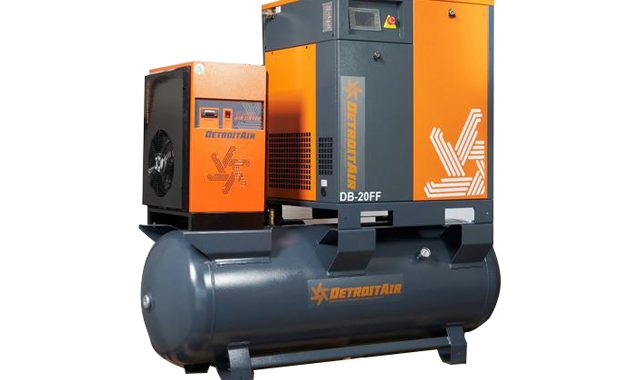Air compressors are used for many workshop tools that need compressed air to function.
Tools like nailers, impact wrenches, sanders, paint sprayers, drills, tyre inflators and even unclogging the kitchen sink all use compressed air.
Air compressors force air into a container to pressurise it and then release the compressed air. Visualise what an inflated balloon does when you let it go and it shoots like a wild rocket. They are positive displacement compressors.
Air compressors function at higher temperatures in locations where the risk of explosions and fire hazards restrict other forms of energy.
There are two types of compressors used in auto repair shops.
Rotary compressors
Rotary compressors use screws or vanes to move and compress the air.
Piston compressors
Piston compressors use a piston driven by a crankshaft to compress the air.
Advantages of compressors
- The advantage of a compressor in a workshop is that only one compressor drives a range of workshop tools.
- That means workshop tools can be mobile and make less noise than they would do if every tool needed its own compressor. It is also more affordable because it saves on the cost of multiple compressors and maintenance.
- Compressors provide on-demand pressurised air.
- Air is free.
- Air provides clean energy.
- It does not pollute in case of system damage or failure.
- Compressors reduce the volume of gas and that means less space needed for storage in relation to the amount of energy it provides.
- Air tools have fewer moving parts which mean it is cheaper to buy and maintain, safer and lighter.
Tools that work with air compression
GTS stock a range of workshop tools that work with compressed air.
- Pneumatic brake bleeder
- Nitrogen machines
- Mobi Porta Power Kit
- Automatic tyre changers
- High-volume tyre changers
- Vehicle lifts
Air dryers
Air- compressors not only supply compressed air, but they also generate water which contributes to breakages and high maintenance of your pneumatic tools and equipment. Equipment and air tools are not designed to have water run through them and therefore it is imperative to add an air-dryer to your air compressor. The days of purchasing a compressor without the dryer have become few or perhaps the budget might be tight.
Dryers come in various sizes to match the size of the compressor output, and this is the case to ensure optimal effectiveness to provide a dry airline. The too-small dryer will not take all the water out of the line and a too big dryer will ice up your airline, so speak to one of our consultants to guide you.
“I don’t need an air dryer; I have multiple water traps on my airline”.
These words are far from the truth, water traps do help but they are believed to only take out about 15% of the water in a typical airline.
Please note that some compressors come with “ built-in” air dryers from the factory and some compressors need an “ aftermarket” job in order to build one next to your existing compressor. Either way, you need a 220volt plug point in your compressor bay to be
installed for your dryer.
Airline
Airlines can be constructed using either galvanized pipe, copper, or plastic.
All these types will suffice however, each one has its positives and negatives, again we can discuss the differences.
Please take care before accepting an airline installation because there is much to consider as getting this wrong could ruin the effectiveness of your compressor’s ability to provide an effective air demand.
The wrong type of installation and inferior air fittings could cause you to spend more money on electricity, have restricted air flow and cause unequal air pressures in the line. Do it once and get it right the first time!
Not all compressors are equal. A reliable and trustworthy adviser will lead you to get the best quality and most productive size compressor for your business.

